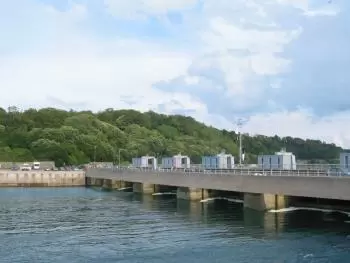
Tidal energy is a way of generating electricity through the movements of water caused by tides.
This type of energy is considered a renewable energy source. In addition, it is a clean energy because it does not emit greenhouse gases to generate electricity.
There are other ways to harness marine energy. Among them are:
-
The difference in water temperatures at different depths.
-
The energy of wave motion or wave energy.
-
The differences between the thermal gradient of the salinity of the water.
Types of tidal power plants
There are three types of tidal power plants:
Tidal currents in the generator
Tidal power generators are hydraulic turbines that are powered by the kinetic energy of moving water. Tides are one of the generators of marine currents. These generators work as if they were windmills.
Tidal dams
Tidal reservoirs use the potential energy generated by the difference in height between the tides. A tidal dam consists of a wall that collects water at high tide. When the tide goes out, the floodgates open and the falling water drives the hydraulic turbines.
Dynamic tidal energy
A dynamic tidal power plant is based on taking advantage of the interaction between:
-
The potential energy of different levels of tidal water
-
Kinetic energy
In this system, long reservoirs of several kilometers are built with various phases of the tide.
This type of construction can be found in countries such as China, South Korea or the United Kingdom .
Advantages of tidal or marine energy
Tidal energy has the following advantages:
-
It is a renewable energy: this type of power plant takes advantage of the energy of the tides. Tides are a consequence of the gravitational interaction of the Moon, the Sun and the Earth, that is, a resource that cannot be depleted.
-
It is a clean energy, this type of energy does not emit greenhouse gases and therefore does not contribute to global warming of the Earth.
-
Tidal power plants do not generate noise pollution.
-
It can be said to predict the movement of the tides and therefore carry out energy planning.
-
It is also energy efficient thanks to the density of water, therefore energy can be obtained by running the turbines at low speed.
-
Once the facilities are built, they are easy to maintain and power generation is economically affordable.
Disadvantages of tidal energy
The main limits of these plants are:
-
The high cost of installation in relation to the amount of energy that can be obtained.
-
The difficulty of the installation (the ideal sites must have tidal amplitudes greater than 3 meters and a topography favorable to the installation)
-
Production discontinuity
-
Coastal erosion created by power plants that modify tidal flows.
-
The tendency to sedimentation within the basin (especially if placed at the mouth of rivers)
-
The disturbance of the ecosystem, in particular for the fauna.
Future prospects for tidal energy
Among the various sources of marine energy, the development and utilization of tidal energy is the most realistic and simple.
In general, the current technical problems in the development and utilization of tidal energy have been resolved. There are many successful examples in the world and technology is updated very quickly.
Tidal power generation uses the potential energy of the tidal range. The highest tidal range in the world is more than 10 meters. Therefore, it is impossible to use water sources tens of meters or more than 100 meters to generate electricity like ordinary hydroelectric power.
However, if a larger hydro turbine is built in the future, the cost of the support facilities will increase accordingly.